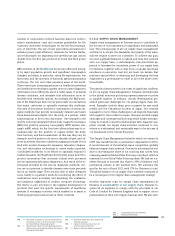Siemens 2011 Annual Report Download - page 164
Download and view the complete annual report
Please find page 164 of the 2011 Siemens annual report below. You can navigate through the pages in the report by either clicking on the pages listed below, or by using the keyword search tool below to find specific information within the annual report.
6 A. To our shareholders
23 B. Corporate Governance 51 C. Combined management’s discussion and analysis
52 C. Business and operating environment
80 C.2 Fiscal – Financial summary
83 C. Results of operations
101 C. Financial position
114 C. Net assets position
117 C. Overall assessment of the economic position
118 C. Report on post-balance sheet date events
119 C. Report on expected developments and
associated material opportunities and risks
135 C. Information required pursuant to Section ()
and Section () of the German Commercial
Code (HGB) and explanatory report
ate worldwide on-site sustainability audits by external experts
to ensure the fulfillment of our standards and to encourage
sustainable business conduct throughout our entire global
supply chain. In addition, we made the Siemens Energy Effi-
ciency Program available to suppliers. We work with our sup-
pliers to conduct environmental and energy efficiency checks,
and identify opportunities for reducing the consumption of
energy and other resources. In this regard, we draw upon the
expertise and know-how gained in connection with our own
environmental program and our Environmental Portfolio.
With the start of the roll-out in the current fiscal year, we are
focusing first on a consulting approach with onsite assess-
ments at selected suppliers. In fiscal , a second wave of
the Siemens Energy Efficiency Program will follow featuring a
cost-free self-assessment tool. So far we have received posi-
tive feedback on the program and are confident that the first
, suppliers will have joined it by the end of fiscal .
C... PRODUCTION AND QUALITY MANAGEMENT
In-house production is one of the most important corner-
stones of our operations. Siemens operates in excess of
major production and manufacturing plants in more than
countries worldwide, including facilities at certain joint
ventures and associated companies. A major production and
manufacturing plant is defined as a facility at Business Unit
level, in which raw or source materials are transformed into
finished goods on a large scale by using equipment and pro-
duction resources such as machines, tools, energy and labor.
Around major production and manufacturing plants are
located in the region Europe, C.I.S., Africa, Middle East; around
major production and manufacturing plants are located in
the region Americas and around major production and man-
ufacturing plants are located in the region Asia, Australia. With
more than major production and manufacturing plants,
the Industry Sector accounts for the greatest proportion of
these, followed by the Energy Sector (around major facili-
ties) and the Healthcare Sector (around major facilities).
Key elements of our production site strategy are the sustained
improvement in the cost position for our products and solu-
tions as well as the development of new markets. In one of
our largest growth markets, China, we have a presence based
on major production and manufacturing plants. One of the
most significant features of our production activities is the di-
versity of products, volumes and processes: The spectrum of
our products ranges from hearing aids to a -tonne steam
turbine; production volume can be anything from a single
customer-specific order to high-tech serial production; and
production processes range from automated production in
clean-rooms to manual final assembly of major installations
on construction sites.
Through the adoption of the Siemens Production System
(SPS) we aim to continuously improve our global production
processes. The SPS is our structured approach to designing
and operating the production operations of Siemens in accor-
dance with the Lean principles. These principles are directed
at generating customer value by reducing activities with no
customer value add in our business processes through vari-
ous methods and principles. This helps us satisfy the increas-
ingly demanding requirements of our customers as well as
consolidate our cost position and that of our customers com-
pared with competitors.
With the implementation of the Lean principles in our produc-
tion operations we aim to simultaneously achieve both short-
er lead times and higher quality in our processes, products
and solutions. This again enables us to react even more flexi-
bly to our customers’ demands and to increase our delivery re-
liability. Our employees play a major role in this process by liv-
ing the principle of continuous improvement. By now, the SPS
has already been established in more than of our major
production and manufacturing facilities worldwide.
It is our strategy to ensure that all of our production and man-
ufacturing facilities apply the Lean principles and that these
principles are also adopted by indirect functions such as ad-
ministration or engineering. For the latter purpose, we have
widened the range of our lean expert qualifications by add-
ing specific training programs for employees engaged in ad-
ministration and engineering & development. By the end of
fiscal , an accumulated total of more than employees
have joined (and in part already completed) lean expert quali-
fication programs for production and / or administration.
Another important step in fiscal was the set-up of SPS co-
ordinators in our regional organizations in order to provide spe-
cific support to the Divisions in their local production facilities.
We believe that Siemens is known for high quality as an es-
sential component of meeting customer needs. Outstanding
quality in our products and solutions is therefore a key suc-
cess factor for our Company. We aim to maintain a strong cul-
ture of continuous improvement and high transparency. In
this context Siemens has developed a comprehensive quality
























